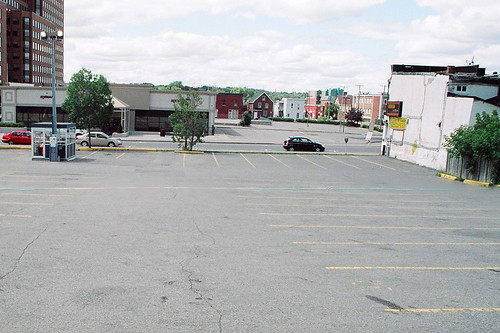
A great collection of prints, one for each element in the periodic table.
sci‧ence [sayh-UHns] n: the study of deviant behavior; why things are not as we expect them to be.
what does that make the philosophy of science?
 |
there are few frustrations like driving around looking for a parking space, which has its own environmental impacts. Shoup studied a 15-block district in Los Angeles and found that drivers spent an average of 3.3 minutes looking for parking, driving about half a mile each. Over the course of a year, Shoup calculated the cruising in that small area would amount to 950,000 excess miles traveled, equal to 38 trips around the earth, wasting about 47,000 gallons of gas, and producing 730 tons of carbon dioxide that contribute to global warming.
Wonder why the mall parking lot is half empty most of the time? Developers build parking lots to accommodate shoppers on the busiest shopping day of the year -- the day after Thanksgiving -- so that shoppers need never, ever park on the street. Similarly, the church parking lot is designed to accommodate Christmas and Easter services. So a whole lot of land gets paved over that doesn't have to be, transportation planners argue.

Ryan Avent excerpts a bit from an interesting paper by Edward Glaeser, Matthew Kahn, and Jordan Rappaport. Let WRich be a rich person's opportunity cost of time, F be the fixed time cost of public transportation, and C be the fixed time cost of driving you get:What I like about this model is that it's easy to speculate about how changes to one variable can feed back into the others--and we can see who the changes would benefit. In the posited four-ring city, a fare decrease would benefit the current ridership, of course, but it won't convince the rich drivers of the third ring to ride, because the significant cost is time, not cash. Faster trains and buses would be more convincing to this population. An increase in C (in the form of tolls or parking fees) should effectively target the rich drivers of ring three, but might unfairly burden the poor long-distance commuters of ring four. Of course, as ridership increases, the time-cost of riding increases and the time-cost of driving decreases. Lowered highway speed limits could restore the balance.Alternatively, if WRichF < C then some rich people will take public transportation. In this case, a four ring city can be one outcome. In the inner ring, the rich take public transportation. In the next ring, the poor take public transportation. In the third ring, the rich drive and there may be a fourth ring where the poor drive.

The tools we use to gather, store, and analyze information inevitably exert a strong influence over the way we think.Now that the internet is our go-to tool,
What I wonder, as a long-ago philosophy instructor, is whether today's students, who are used to this "horizontal grazing" style of research, can any longer appreciate the long, complex logical structures that were traditionally regarded as serious thought.
This is from a great flickr collection--tons of great evolution-related images free for use in lectures.
 Much of what goes on on a site like facebook can be considered, by the cynical among us, signaling behavior--that is, because we have such freedom of choice as to what we include or elide, virtually everything on facebook counts as a personal advertisement. Most native English-speakers have read "Hamlet" once or twice in our lives, but not all of us would include it as a favourite book. For those who do, it serves as a signal, an affiliation, or an invitation. Thanks to attentions from the more quantitatively inclined, "Hamlet" also signals an SAT score in the 1000 range. The idea is to mine the apparently harmless public data facebook collects for various affiliations, like "the 10 favorite books at the University of Toronto," and presume a correlation with other known characteristics of that affiliation, in this case the published average SAT levels. Finally, we can look at our own facebook friends to see if any of them lists "Hamlet" as a favourite book. If they do, then by the improper logic that accompanies all signaling behaviour, their SAT scores must be in the 1000 range. Lolita, One Hundred Years of Solitude, and Crime and Punishment are smarty-pants signals (1300+ SATs), though I imagine that the release of a film for One Hundred Years will be a near-term spoiler.
Much of what goes on on a site like facebook can be considered, by the cynical among us, signaling behavior--that is, because we have such freedom of choice as to what we include or elide, virtually everything on facebook counts as a personal advertisement. Most native English-speakers have read "Hamlet" once or twice in our lives, but not all of us would include it as a favourite book. For those who do, it serves as a signal, an affiliation, or an invitation. Thanks to attentions from the more quantitatively inclined, "Hamlet" also signals an SAT score in the 1000 range. The idea is to mine the apparently harmless public data facebook collects for various affiliations, like "the 10 favorite books at the University of Toronto," and presume a correlation with other known characteristics of that affiliation, in this case the published average SAT levels. Finally, we can look at our own facebook friends to see if any of them lists "Hamlet" as a favourite book. If they do, then by the improper logic that accompanies all signaling behaviour, their SAT scores must be in the 1000 range. Lolita, One Hundred Years of Solitude, and Crime and Punishment are smarty-pants signals (1300+ SATs), though I imagine that the release of a film for One Hundred Years will be a near-term spoiler.